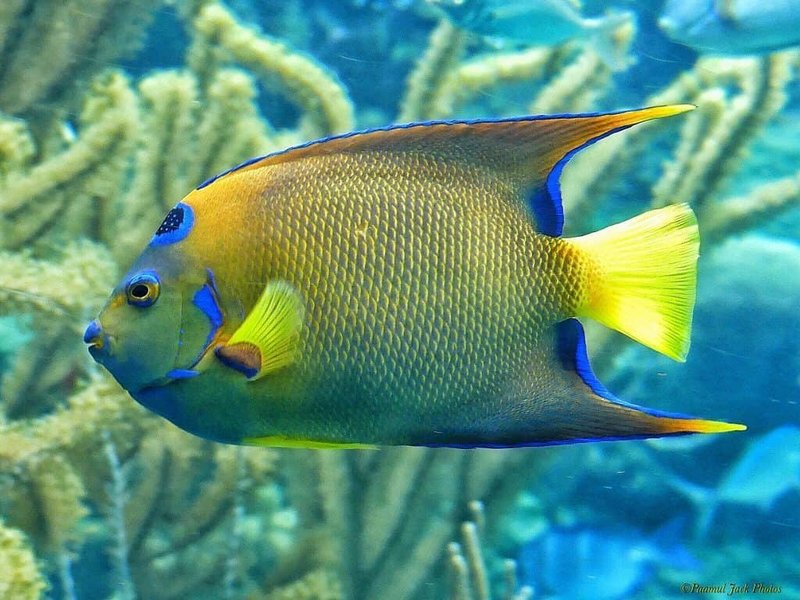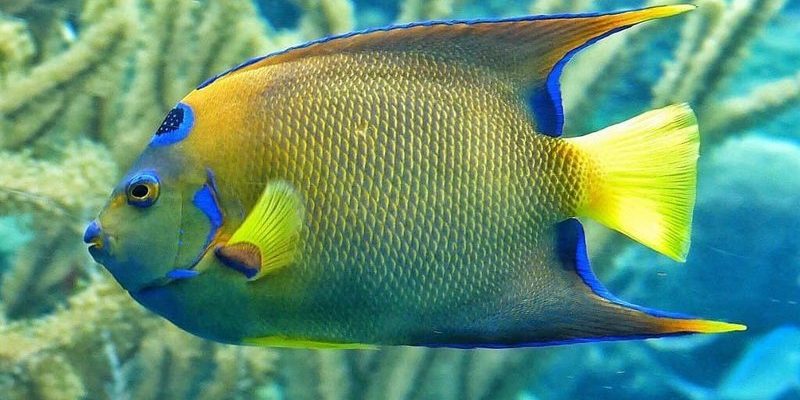
The Queen Angelfish is like the dazzling diva of the coral reefs, flaunting vibrant colors and a majestic presence. Imagine a colorful creature gliding gracefully through the water, surrounded by swaying corals and curious fish—this is the world of the Queen Angelfish. Found primarily in the warm waters of the Caribbean and the Gulf of Mexico, this species captures the hearts of divers and marine enthusiasts alike. But what makes this fish so special? Let’s dive into the fascinating life of the Queen Angelfish.
Typically recognized for its striking blue and yellow hues, the Queen Angelfish isn’t just a pretty face. It plays a crucial role in its ecosystem, helping to keep coral reefs healthy by grazing on algae. If you’ve ever been snorkeling or diving, you might have spotted one drifting elegantly among the corals, its colors shimmering as it moves. These fish are not just beautiful; they have interesting behaviors and unique traits that are worth exploring more deeply.
Physical Appearance
When you first encounter a Queen Angelfish, you might be taken aback by its stunning appearance. The adults typically showcase a rich blue body with yellow and black markings, while the juvenile fish sport a more muted color palette with bold stripes. It’s almost as if they’re wearing the jewels of the ocean! The vibrant colors serve not only for beauty but also for communication and camouflage among the intricate reef structures.
A fun fact is that the Queen Angelfish can grow up to about 12 to 14 inches in length. This size makes them one of the larger angelfish species found in the Caribbean. With their long, graceful fins and distinctive circular, yellow crown marking on their foreheads, they truly embody royalty in this underwater domain. Their bodies are designed for agility, allowing them to navigate through tight spaces within the coral reefs effortlessly.
Habitat and Distribution
You’ll mostly find the Queen Angelfish in shallow coastal waters of coral reefs, usually at depths ranging from 10 to 100 feet. They prefer areas with plenty of coral cover, where they can find shelter from predators as well as plenty of food. This fish generally hangs out around the reefs of the Caribbean Sea, especially around locations like Belize, the Bahamas, and the Florida Keys.
In terms of distribution, the Queen Angelfish is quite widespread. Their habitat spans the Caribbean and extends to parts of the Gulf of Mexico, making them relatively easy to spot for divers and snorkelers. They are often seen in pairs or small groups, which adds to their social and vibrant nature. However, like many marine species, their populations can be affected by factors like environmental changes and human activities.
Diet and Feeding Habits
The Queen Angelfish is primarily a herbivore which means it enjoys a diet mainly made up of algae, sponges, and other plant life found on the reefs. They spend a good part of their day grazing on these organisms, helping to keep the reef clean and balanced. Isn’t that fascinating? Just imagine them like little gardeners of the sea, tending to their underwater gardens!
Interestingly, they have specialized feeding habits that allow them to reach into the crevices of the reef to access food that other fish might miss. Their small, pointed mouths are perfect for scraping algae off the surfaces of rocks and corals. This adaptation is vital for their survival as it helps them thrive in environments that might not provide abundant food sources.
Behavior and Social Structure
Queen Angelfish are known for their unique behaviors, especially when it comes to social interactions. They are quite territorial and often establish a home range where they can feed and mate. When you observe them in their natural habitat, you might notice them engaging in playful swimming and social displays, which is a part of their courtship rituals.
These fish generally live in pairs, especially during the breeding season, which adds a romantic touch to their lives. They exhibit some fascinating courtship behaviors, including synchronized swimming and elaborate displays that highlight their vibrant colors. This social structure is essential for their breeding success and helps ensure healthy populations of Queen Angelfish.
Reproduction and Lifespan
In terms of reproduction, Queen Angelfish are quite fascinating. They participate in a spawning process, typically during the warmer months when water temperatures rise. The males and females will perform a series of courtship dances that culminate in the release of eggs and sperm into the water column. This spectacle is not only mesmerizing but vital for the continuation of their species.
As for their lifespan, Queen Angelfish can live up to around 15 years in the wild, though many face various threats that can shorten their lives. Predation, habitat loss, and environmental changes are significant challenges they face. This makes it all the more essential to protect their habitats to ensure future generations get to experience the beauty of these creatures.
Conservation Status
The conservation status of the Queen Angelfish is something to be mindful of. While they are currently not considered endangered, their populations can be impacted by overfishing and habitat destruction. Coral reef degradation, particularly due to climate change, poses significant threats to their environment. Each of us can play a role in protecting these beautiful fish by supporting sustainable practices and conservation efforts.
Organizations focused on marine conservation often work to restore coral reefs and protect the habitats where Queen Angelfish thrive. By spreading awareness and supporting these initiatives, we can help ensure that future generations will be able to marvel at the Queen Angelfish just like we do today.
Interesting Facts about Queen Angelfish
| Fact | Detail |
|---|---|
| Scientific Name | Holacanthus ciliaris |
| Size | 12 to 14 inches |
| Diet | Herbivorous; primarily eats algae and sponges |
| Habitat Depth | 10 to 100 feet |
| Lifespan | Up to 15 years |
| Conservation Status | Not endangered but vulnerable to habitat loss |
FAQ
How can you identify a Queen Angelfish?
Identifying a Queen Angelfish is quite easy due to its vibrant blue and yellow colors. Look for the characteristic circular, yellow crown on its forehead and its elongated, graceful fins. Juvenile Queen Angelfish have a different pattern, featuring more prominent stripes that help them blend into their surroundings.
Are Queen Angelfish aggressive?
Generally, Queen Angelfish are not aggressive but are territorial. They may defend their space against intruders, especially during breeding times. However, they usually coexist peacefully with other fish, especially when their habitat is abundant and offers plenty of food. It’s important to provide them with space in a home aquarium to prevent any potential squabbles.
What environment do Queen Angelfish prefer?
Queen Angelfish thrive in coral reefs and prefer warm waters with plenty of coral cover. They are often found in shallow coastal areas, so maintaining clean, well-structured reef environments is crucial for their well-being. Ensuring the availability of food sources like algae and sponges is also important for their habitat.
Can Queen Angelfish live in a home aquarium?
While it’s possible to keep Queen Angelfish in home aquariums, it requires a large tank with plenty of space because they need room to swim and explore. Additionally, maintaining the right water conditions and providing adequate filtration is essential, as these fish are sensitive to water quality. Remember, it’s crucial to replicate their natural habitat as closely as possible.
What is the best way to feed Queen Angelfish in captivity?
In captivity, Queen Angelfish can be fed a balanced diet that includes high-quality flakes or pellets designed for marine fish. Supplementing with fresh or frozen foods such as algae, spirulina, and marine vegetables will help mimic their natural diet. Providing a varied diet is key to keeping them healthy and thriving.
Do Queen Angelfish change color as they age?
Yes, Queen Angelfish do change color as they mature. Juveniles have a more muted color palette with striking stripes, while adults boast bold blue and yellow hues. This transformation is part of their growth and development, allowing them to adapt better to their surroundings and social structure.
What threats do Queen Angelfish face in the wild?
Queen Angelfish face several threats, including habitat loss due to coral reef degradation and pollution. Overfishing can also affect their populations, particularly in areas where they are hunted for the aquarium trade. Conservation efforts are crucial to protect them and their habitats, ensuring they continue to thrive in the wild.
How can I help in the conservation of Queen Angelfish?
You can help by supporting marine conservation organizations and spreading awareness about the importance of protecting coral reefs. Practicing sustainable fishing and avoiding products that harm marine environments are excellent steps. By choosing eco-friendly alternatives and advocating for sustainable practices, you contribute to the preservation of these stunning creatures.

